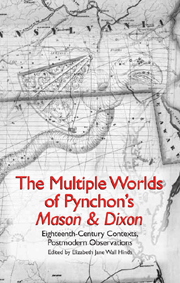 The Multiple Worlds of Pynchon's 'Mason and Dixon'
The Multiple Worlds of Pynchon's 'Mason and Dixon' Book contents
- Frontmatter
- Contents
- Preface
- Note on Quotations from Mason & Dixon
- The Rounds of History
- Introduction: The Times of Mason & Dixon
- 1 “The Space that may not be seen”: The Form of Historicity in Mason & Dixon
- Consumption Then and Now
- Space and Power
- Enlightenment Microhistories
- Works Cited
- Notes on the Contributors
- Index
1 - “The Space that may not be seen”: The Form of Historicity in Mason & Dixon
from The Rounds of History
Published online by Cambridge University Press: 12 September 2012
- Frontmatter
- Contents
- Preface
- Note on Quotations from Mason & Dixon
- The Rounds of History
- Introduction: The Times of Mason & Dixon
- 1 “The Space that may not be seen”: The Form of Historicity in Mason & Dixon
- Consumption Then and Now
- Space and Power
- Enlightenment Microhistories
- Works Cited
- Notes on the Contributors
- Index
Summary
So if I draw a boundary line that is not yet to say what I am drawing it for.
— Ludwig Wittgenstein, Philosophical InvestigationsAT THE CONCLUSION OF Mason & Dixon's thirty-second chapter, Jeremiah Dixon receives a letter from his long-time mentor, William Emerson, who has entrusted Dixon with a watch of perpetual motion that never requires winding. Dixon has written to Emerson to report that the watch was swallowed by R.C., a member of the surveying party, and Emerson's reply bears the challenging post-script, “Time is the Space that may not be seen. —” (326). This essay reads Mason & Dixon as a literary attempt, not to render time visible, but to produce meaning from time itself. As such, Thomas Pynchon incorporates temporality into the narrative's production, not only writing about the historical interface between the eighteenth and twentieth centuries, but also performing the historicity of that interface. To make meaning from time's perpetual motion, Pynchon employs a temporally parallactic narrative form (different narrators deliver the story from ostensibly different moments in time) that effects, for the reader, a semblance of experiential time. These narrative tricks superimpose linear and cyclical models of time into one textual form, and they allow Pynchon to write about time without sacrificing, by spatializing, time's temporality or history's historicity.
- Type
- Chapter
- Information
- The Multiple Worlds of Pynchon's 'Mason and Dixon'Eighteenth-Century Contexts, Postmodern Observations, pp. 25 - 46Publisher: Boydell & BrewerPrint publication year: 2005
